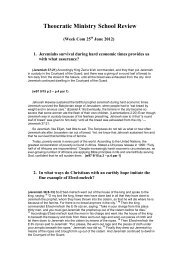1964 Awake! - Theocratic Collector.com
1964 Awake! - Theocratic Collector.com
1964 Awake! - Theocratic Collector.com
You also want an ePaper? Increase the reach of your titles
YUMPU automatically turns print PDFs into web optimized ePapers that Google loves.
THE<br />
,..,AKIKUYU<br />
MAKE A<br />
8"<br />
INHABITING approximately<br />
one<br />
million acres in the East African country<br />
of Kenya, the Wakikuyu tribe has recently<br />
been <strong>com</strong>pelled, by circumstances, to undergo<br />
a change that is vital to its economic<br />
survival. They are an agricultural people<br />
and the cha,nge has affected what they depend<br />
upon for their livelihood-their land.<br />
Before the Europeans came to Kenya all<br />
the land of the Wakikuyu belonged to<br />
clans. Each clan laid claim to certain land<br />
areas. Through the clan elders, land was<br />
apportioned to individual members of the<br />
tribe, making them the lawful owners. The<br />
binding of their ownership was by means<br />
of a sacrificial goat, which was divided<br />
among the elders. In some clan areas, a<br />
plant called a "matoka lily" was planted as<br />
a boundary marker after its roots had<br />
heen dipped in the intestines of the slain<br />
goat. The new landowner then built his<br />
house on the land with its door facing<br />
Mount Kenya, where the tribe believed<br />
that their god resided.<br />
Over the years these landholdings became<br />
fragmented, because many members<br />
of the tribe desired to have land at various<br />
altitude levels and also because Of the<br />
tribe's inheritance system. For example,<br />
the sons of a family always inherited their<br />
father's land, but the land they inherited<br />
would not necessarily be in the same area<br />
as that already owned by the sons. Thus<br />
NOVEMBER 8, <strong>1964</strong><br />
By "<strong>Awake</strong>l" correspondent in Kenya<br />
the sons would <strong>com</strong>e to own two portions<br />
of land in different areas. With the passing<br />
of successive generations landownership<br />
could involve numerous pieces of widely<br />
scattered land. In one case a landowner<br />
possessed five and a half acres, but this<br />
was <strong>com</strong>posed of forty-two widely scattered<br />
fragments.<br />
A serious problem confronted the Wakikuyu<br />
when their growing population became<br />
faced with a shortage of land. With<br />
the land they had fragmented, it was not<br />
possible for them to produce enough for<br />
their growing numbers. A change in the<br />
tribal land system became an economic<br />
necessity.<br />
The Objective of Land Reform<br />
The primary objective in changing the<br />
tribal system of land tenure was to bring<br />
about a balanced economy. By consolidating<br />
landholdings, it was hoped that a better<br />
standard of living could be achieved,<br />
because soil conservation measures could<br />
be practiced, crop rotation could be carried<br />
on as well as other farming methods<br />
that have proved practicable. It should<br />
seem obvious that a landowner could do<br />
more with his land, making it more productive,<br />
if it were all in one piece rather<br />
than fragmented into many widely scat-<br />
25




